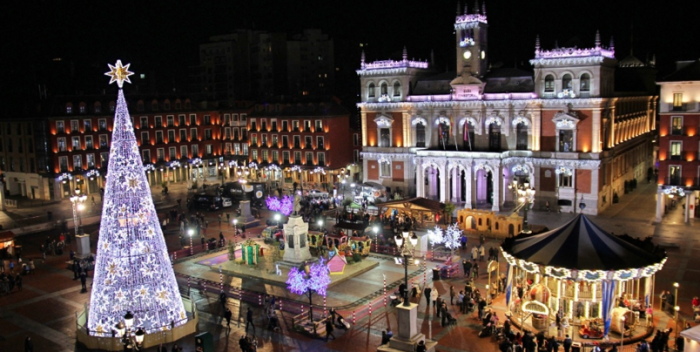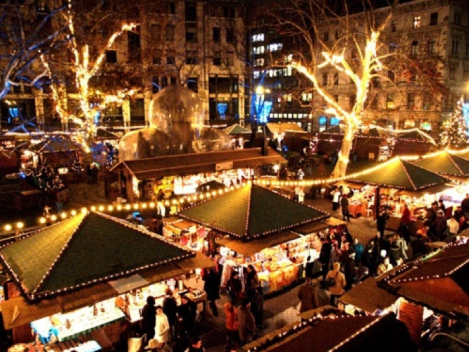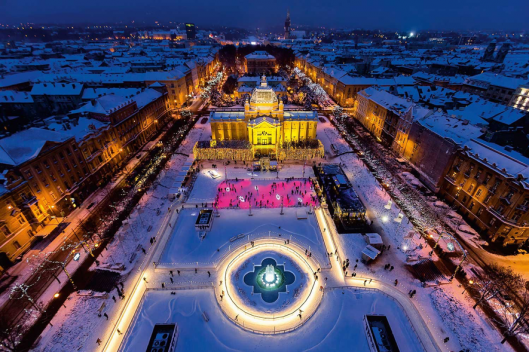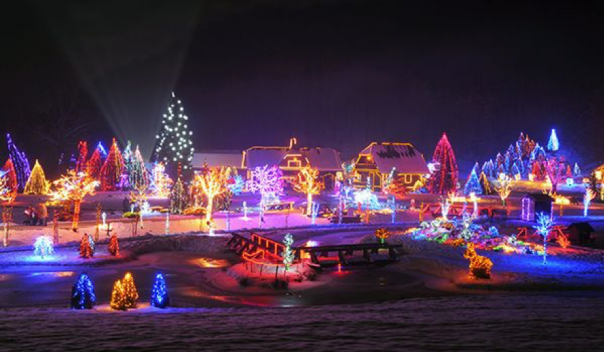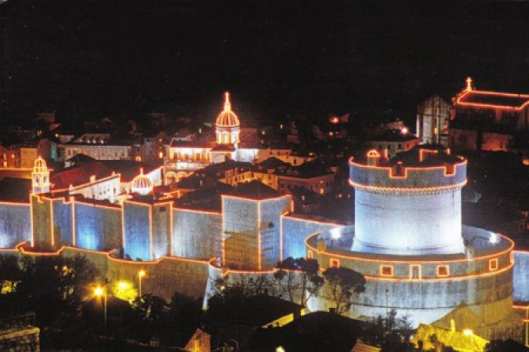Christmas: The tradition of consumerism
Christmas is all about family and sharing happiness and, of course, celebrating the birth of Jesus Christ. A time for tradition, encounter, reconciliation and requests for peace, love and prosperity. At least in theory. Around 174 countries of the 201 existing celebrate Christmas. Both Croatia and Spain are included in that group, even if, obviously, each has its own customs.
SPAIN
Between December and January, Christmas is celebrated throughout Spain, mixing religious traditions with pagan traditions. Although the official date is the 24th, everyone knows that Christmas starts on December 22nd, the day in which the National Lottery is broadcasted on tv. Many people buy their lottery ticket months before and wait for the children who are singing the numbers to say theirs. From this moment on, both those who have tried their luck and those who haven’t, all know that Christmas time has come.
The streets are at their best, with lights and decoration. The smell of chestnut, the atmosphere, the turrons on the shelves of the houses, the toys and the Christmas markets have become the leitmotiv of the announcements during this time of the year.
All these markets have their place in the square of every town. Wooden stalls, colored lights, an amalgam of smells that bring back memories of childhood, many ornaments. Nobody can deny that they have a special charm, although some are better than others. Put on your hats, and do not forget the gloves and the scarf, we are going to make a trip to the most beautiful Christmas markets in Spain.
The Plaza Mayor is an emblematic place in the capital the whole year, but at Christmas it becomes a dream-like place. The Plaza Mayor market is the most famous one in Madrid, attracting a large number of tourists from all parts of the world. It is a space of ample dimensions where you can find almost everything related to this date: Christmas sweets, ornaments for the house, figurines of the nativity scene, crafts and even articles to play pranks on your friends and family during the day of the Holy Innocents.
The Santa Lucía Fair has become the main Christmas market in Barcelona. Located in the Gothic quarter, it has the magnificent Gothic cathedral of Santa Eulalia as its backdrop. It is one of the oldest markets in Spain, with more than 225 years of tradition, and it’s divided into several sectors: the green sector – dedicated to Christmas trees – the craft sector and a sector dedicated to the figures of the nativity scene, where you can find the famous “caganer”. There’s also a trunk called Tio de Nadal that, according to Catalan tradition, and after singing a Christmas carol around it, must be chopped to sticks so it “shits” gifts for children on Christmas Eve.
El Barón de Cárcer Christmas Market in Valencia has its enclave between the streets of the Central Market of Valencia. With more than 300 stalls, it is one of the largest in Spain, and there we can find many sweets like gingerbread, roasted chestnuts, decorations etc.
Santa Lucía fair in Barcelona
La Feria de los Belenes in Seville is one of the most important in Spain in its modality. It islocated surrounding the Cathedral of Seville and the General Archive of the Indies. In the stands of the Fair, items and figures are sold to decorate both the nativity scene and the tree.
The Christmas Trade and Craft Market in Zaragoza is located in a privileged place in front of the Basilica del Pilar de Zaragoza. It has 40 stands where you can buy any object related to this special date. In front of the facade of the famous monument an immense nativity scene of almost 2,500 square meters is built. In addition, there are endless activities for the children: parades, music, games and an ice skating rink, just to name a few.
Bib-Rambla Christmas Market takes place in the center of the city of Granada, in the Bib-Rambla square, near the imposing cathedral. 70 stalls can be found in this familiar flea market where they sell everything from gift items to products as typical of Christmas.
The Christmas Trade and Craft Market in Zaragoza
CROATIA
The “magic” of Christmas in Croatia is a very important tourist attraction. For this reason, this kind of tourism – that is ephemeral but attracts thousands of visitors during the month of December throughout the whole country – is increasingly getting more and more recognition.
In 2016, Zagreb was chosen as the best Christmas Destination in Europe by European Best Destination, and in 2017 it was the Best European Destination for Lonely Planet, something that is not surprising, because of the interest and work that its people have dedicated to converting the capital of Croatia in a true Christmas Tale during this time of the year. In Zagreb, we can really feel the Christmas spirit that books and movies talk about, thanks to the atmosphere that soaks every corner of the capital.
One of the most visited parts of the city is the Dolac Market, where our palate will overflow with joy as we try the different Christmas products of each region. Of course, walking under the cheerful lights while we enjoy the beautiful sight of the Cathedral is already a luxury for all the senses.
King Tomislav Square, Zagreb
Very close to Zagreb, about 60 km away, we can find the estate of the Salaj Family, in Grabovnica, a dream-like place that was shaped by the illusion of its owners, who decorate it every year, and that has become a tourist attraction worthy of a visit. The lights and music will dazzle us as we feel like children again. Who knows if Santa Claus will decide to go live in this magical place some day?
The estate of the Salaj family, Grabovnica
From the first days of December, we will be able to visit the Christmas Fair that is in the vicinity of Josipa Jelacica Square, famous for its advent wreath, that surrounds the fountain, while the children can enjoy the Christmas Train and the Ice Rink.
And Christmas has not only reach Zagreb, nor the rest of Croatia, nor the interior of the country, but also the Adriatic coast. Places like Dubrovnik host miles of visitors that get lost in its great Christmas Market, that begins on December 13 – the festivity of St. Lucia. Near Zrinjevac Squere we can behold the lights, the decorated streets and the numerous stalls where we can purchase beautiful Christmas memories and taste the famous mulled wine while we eat some of its typical sweets.
Every year the famous Concert of the Dubrovnik Symphony Orchestra lure children, young people and adults in, and the athletic ones find their place in the New Year’s Race.
Dubrovnik, Croatia
We should also take a moment to appreciate the melodies that sound during these dates throughout Croatia, the traditional songs of the Klapas, that immerse us in the Croatian Christmas atmosphere.
The most typical Christmas’s products vary depending on the geographical area, but some are common throughout the country, such as the sweets made with chocolates, gingerbread cookies and apples (it’s said that the apple is a symbol of love, and that if a boy gives it to his partner during Christmas Eve, he’s offering his eternal love as well). During these days, they will offer us cod soup, a beef stew called “pasticada” – really tasty – “sarma”, which is cabbage stuffed with meat and rice, or “krostule”, some kind of frosty cookies. Also, just like how it happens in many European places, like Spain itself, we may be mesmerized by the smell of roasted chestnuts as we wander through the streets. Other products that will captivate us are the sausages roasted in the street stalls, as well as the typical donuts, called “prikle”. In the north of the country we are able to savor the “struklis”, a kind of cheese cakes that can be sweet or salty and accompanied by different types of fruit jam.
The sound of Christmas carols can be heard in other places like Split, where, besides the markets and fairs, we can see live representations of the nativity scene or skate on ice rinks, all the while enjoying a mild hot winter, with the Adriatic Sea in front of us.
In the Peninsula of Istria, places like Pula, Osijek, Opatija, Rovinj or other small localities of the area, take pride in their Christmas decorations, and in offering to the travelers and inhabitants the typical meats of the region. Here the truffle is the protagonist, so we will find numerous references to it, such as truffle cheese, oil etc.
In Croatia, Christmas is intensely felt, no matter what place we choose to enjoy these dates in, here they know how to celebrate it. In fact, it is one of the most beautiful Christmas I’ve ever experienced.
THE TRADITION OF CONSUMERISM
However, the essence of this festivity has been lost over time, and the capitalist model prevailing in the world has transformed the holy and the spiritual into a perfect occasion for vanity to shine. Christmas itself is a religious tradition to remember the birth of Jesus Christ on December 25, yet the Christmas celebrations start before and end in January. From the religious to the consumerism, this distinct change is obvious: gifts, new clothes, the decoration of houses and parties are expected from everyone and seen as another tradition. The money spent by families around the world skyrockets with the arrival of this festivity, because it has been established the idea that, in order to celebrate Christmas right, shopping is unavoidable.
Throughout the year, it is common to hear people complain about the prices of products in the market, however, at Christmas these complaints are set aside and the streets and shopping centers are filled with individuals eager to buy what “they need”, without taking into account that at this time the goods are even more expensive. The fever of Christmas can even drag many into debt, or lead them to request for an advance of profits in their jobs. A large number of people usually resort to credit cards to carry these expenses, which are they necessary? In general, what prevails in the decision to spend so much money at this time is not wanting to leave without gifts family and friends. Spending a high sum of money on Christmas holidays seems to be the certification of love towards children, couples, mothers, fathers… among others.
During these dates, merchants use advertising campaigns or promotions so “attractive” that many find it impossible to fall into the trap of consumerism. The great advertising bombing begins more than a month before Christmas arrives, and in general, those who start with this stalking are the toy factories, which through their colorful and fun commercials try to catch the children so that they can in turn drag their parents into buying the product as a Christmas gift. Also, it is very common to see merchants’ “sales” of merchandise, some of them real but others deceptive, it doesn’t matter if it is in a Christmas market or in a big mall. The merchants tend to raise the price of the products and put the word “offer” on big, eye-catching posters, but the consumer is really buying the item to the real cost. So effective are these commercial strategies, that studies in different countries such as Spain, the United States and Colombia, reveal that in the month of December at least 50 percent of purchases are made throughout the year.
The human brain associates Christmas with happiness, gifts, parties, colors, lights and endless happy things, however, in the world there are millions of people who cannot be part of these celebrations so marked by consumerism.
According to data from the United Nations (UN) and the World Bank, close to one billion people on the planet live in extreme poverty. For the por, this time is very sad or they just do not have Christmas. Their condition of life does not allow them to even make a modest Christmas dinner, let alone buy clothes, toys or ornaments. While millions of people go around the world splurging their money on things not so necessary to celebrate these holidays, others just long for a place to live, food and health.
